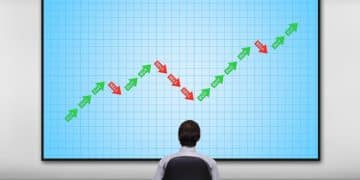Maximize Your 401(k) in 2025: Contribution Limits You Need to Know

Maximize your 401(k) in 2025 by understanding the updated contribution limits, helping you save more effectively for retirement and potentially reduce your taxable income.
Planning for retirement involves making smart financial decisions, and one of the most effective tools available is the 401(k) plan. To maximize your 401(k) in 2025, it’s crucial to understand the updated contribution limits and how they can impact your savings strategy.
Understanding 401(k) Plans: A Quick Overview
A 401(k) plan is a retirement savings plan sponsored by an employer, allowing employees to save and invest for their future. Contributions are often made pre-tax, reducing your current taxable income, with the funds growing tax-deferred until retirement. Many employers also offer matching contributions, providing an additional incentive to participate.
Key Features of a 401(k) Plan
Understanding the core features of a 401(k) can help you make informed decisions about your retirement savings. These features include contribution types, investment options, and withdrawal rules.
- Pre-tax Contributions: Contributions are made before taxes, lowering your current taxable income.
- Tax-Deferred Growth: Investments grow without being taxed until withdrawal in retirement.
- Employer Matching: Many employers match a portion of employee contributions, boosting savings.

It’s essential to grasp these basics to fully maximize your 401(k) in 2025. Understanding the nuances will enable you to take full advantage of the benefits offered and plan more effectively for your retirement.
Contribution Limits for 2025: What’s New?
Each year, the IRS announces updated contribution limits for 401(k) plans, reflecting changes in the cost of living and economic conditions. Staying informed about these limits is crucial for optimizing your retirement savings.
Employee Contribution Limits
The employee contribution limit is the maximum amount you can contribute to your 401(k) each year. For 2024, this limit is $23,000. We have to wait for the IRS announcement to confirm numbers for 2025.
Catch-Up Contributions for Those 50 and Over
For those aged 50 and over, there’s an additional “catch-up” contribution allowed. This provides an opportunity to boost retirement savings as you approach retirement age. For 2024, the catch-up contribution limit is $7,500 and is indexed for inflation.
Keeping an eye on these figures and adjusting your contributions accordingly will enable you to maximize your 401(k) in 2025, building a more substantial retirement nest egg.
Strategies to Maximize Your 401(k) Contributions
Maximizing your 401(k) contributions involves strategic planning and consistent effort. By employing the right tactics, you can significantly enhance your retirement savings.
Take Full Advantage of Employer Matching
One of the most straightforward ways to boost your 401(k) is to take full advantage of any employer matching program. This is essentially free money that can significantly increase your savings.
Increase Contributions Gradually
If you’re not able to contribute the maximum amount right away, consider increasing your contributions gradually. Even a small increase can make a big difference over time.
- Start Small: Begin by increasing your contribution by 1% each year.
- Reinvest Raises: Allocate a portion of any salary increases to your 401(k).
- Review Regularly: Periodically assess your budget and adjust contributions as needed.
By implementing these strategies, you can steadily maximize your 401(k) in 2025, paving the way for a more secure retirement.
The Impact of Maxing Out Your 401(k)
Consistently contributing the maximum amount to your 401(k) can have a profound impact on your long-term financial health. Understanding these benefits can motivate you to prioritize your retirement savings.
Long-Term Growth Potential
One of the most significant advantages of maxing out your 401(k) is the potential for long-term growth. Over time, the power of compounding can turn even modest contributions into substantial savings.
Tax Benefits
401(k) plans offer significant tax advantages. Contributions are typically made pre-tax, reducing your current taxable income. Additionally, your investments grow tax-deferred, meaning you won’t pay taxes on earnings until retirement.
These tax benefits not only help you save more but also reduce your current tax burden, freeing up more funds to maximize your 401(k) in 2025 and beyond.
Common Mistakes to Avoid with Your 401(k)
While 401(k) plans are powerful tools for retirement savings, it’s essential to avoid common mistakes that can undermine your progress.

Not Contributing Enough
One of the most common mistakes is not contributing enough to your 401(k). Many people contribute only enough to receive the employer match, missing out on significant potential savings.
Ignoring Investment Options
Another mistake is ignoring your investment options. Many 401(k) plans offer a variety of investment choices, each with its own risk and return profile. It’s important to diversify your investments to manage risk and maximize growth potential.
By avoiding these common pitfalls, you can maximize your 401(k) in 2025 and ensure a more comfortable retirement.
Planning Beyond the 401(k): Additional Retirement Strategies
While maximizing your 401(k) is a crucial step, it’s also important to consider additional retirement strategies to ensure a well-rounded financial plan.
Investing in an IRA
An Individual Retirement Account (IRA) is another powerful tool for retirement savings. There are two main types of IRAs: traditional and Roth.
In conclusion, 401(k) plans are a cornerstone of retirement savings. Understanding contribution limits, avoiding common mistakes, and complementing your 401(k) with other retirement strategies are essential steps to financial security.
| Key Point | Brief Description |
|---|---|
| 💰 Contribution Limits | Stay informed about annual 401(k) contribution limits set by the IRS. |
| 🤝 Employer Matching | Maximize employer matching to boost your retirement savings. |
| 📈 Gradual Increase | Incrementally increase contributions to reach maximum limits. |
| 🎯 Avoid Mistakes | Be aware of common 401(k) pitfalls to ensure optimal savings. |
FAQ
A 401(k) plan is a retirement savings plan sponsored by an employer, allowing employees to save and invest for their future, often with pre-tax contributions and tax-deferred growth.
The exact contribution limits for 2025 will be announced by the IRS. in the previous year. Be sure to watch for those updates.
“Catch-up” contributions allow those aged 50 and over to contribute extra to their 401(k), helping them boost savings as they approach retirement.
To maximize your 401(k), take full advantage of employer matching, gradually increase contributions, and stay informed about contribution limits.
Common mistakes include not contributing enough, ignoring investment options, and failing to diversify your investments within the 401(k) plan.
Conclusion
Maximizing your 401(k) in 2025 requires staying informed about updated contribution limits and implementing strategic savings approaches. By understanding the plan’s key features, avoiding common mistakes, and complementing it with other retirement strategies, you can secure a more comfortable financial future. Stay proactive, review your plan regularly, and make adjustments as needed to optimize your retirement savings journey.





